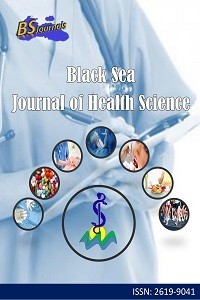Evaluation of the Approaches Adopted by the Infectious Diseases and Clinical Microbiology Specialists and Medical Microbiology Specialists in the Case of Myroides spp. Growth in Urine Culture: A Survey Study
Myroides odoratus, Myroides odoratitimus, Urine culture, Infectious diseases, Medical microbiology, Survey
Evaluation of the Approaches Adopted by the Infectious Diseases and Clinical Microbiology Specialists and Medical Microbiology Specialists in the Case of Myroides spp. Growth in Urine Culture: A Survey Study
Myroides odoratus, Myroides odoratitimus, Urine culture, Infectious diseases, Medical microbiology, Survey,
___
- Ahamed I, Annapandian VM, Muralidhara KD. 2018. Myroides odoratimimusurinary tract infection. Saudi J Kidney Diseases Transplant, 29: 1220-1222.
- Beathard WA, Pickering A, Jacobs M. 2021. Myroides cellulitis and bacteremia: a case report. ID Cases, 24: e01061.
- Beharrysingh R, 2017. Myroides bacteremia: a case report and concise review. ID Cases, 8: 34-36.
- Büyüktuna SA, Öz M, Öksüz C, Hasbek M. 2021. Septhic arthritis caused by Myroides odoratimimus: A Case Report. Flora İnfek Hastalıkları Klin Mikrobiyol Derg, 26: 778-781.
- Crum-Cianflone N, Matson R, Ballon-Landa G. 2014. Fatal case of necrotizing fasciitis due to Myroides odoratus. Infection, 42: 931-935.
- Faraz A, Fathima K, Kazmi SY, Al Motery AS, Ghaffar UB, Farhan MA. 2022. Recurrent urinary tract infection in a renal transplant patient by pan-resistant Myroides spp. J Coll Physicians Surg,32: S34-S36.
- Gunzer F, Rudolph WW, Bunk B, Schober I, Peters S, Müller T, Oberheitmann B, Schröttner P. 2018. Whole-genome sequencing of a large collection of Myroides odoratimimus and Myroides odoratus isolates and antimicrobial susceptibility studies. Emerging Microb Infect, 7: 1-8.
- Holmes B, Snell J, Lapage S. 1977. Revised description from clinical isolates of Flavobacterium odoratum Stutzer and Kwaschnina 1929 and designation of the neotype strain. Inter J System Evolution Microbiol, 27: 330-336.
- Hu S.-h, Yuan S.-x, Qu H, Jiang T, Zhou Y.-j, Wang M.-x, Ming D.-s. 2016. Antibiotic resistance mechanisms of Myroides sp. J Zhejiang Univ Sci, B, 17: 188.
- Khan U, Pandey E, Gandham N, Das N, Mukhida S, Kannuri S, Bhaumik S, Mirza S. 2023. A case series and literature review of infections due to Myroides spp.: Identification of contributing factors and emerging antibiotic susceptibility trends. Access Microbiol, 5: 000549.
- Ktari S, Mnif B, Koubaa M, Mahjoubi F, Jemaa MB, Mhiri M, Hammami A. 2012. Nosocomial outbreak of Myroides odoratimimus urinary tract infection in a Tunisian hospital. J Hospital Infect, 80: 77-81.
- Kurt AF, Mete B, Houssein FM, Tok Y, Kuskucu MA, Yucebag E, Urkmez S, Tabak F, Aygun G. 2022. A pan-resistant Myroides odoratimimus catheter-related bacteremia in a COVID-19 patient and review of the literature. Acta Microbiol Immunol Hung, 2022: 21.
- Kutlu HH, Avcı M, Dal T, Arı O, Durmaz R. 2020. A healthcare-associated outbreak of urinary tract infections due to Myroides odoratimimus. Japanese J Infect Diseases, 73: 421-426.
- LaVergne S, Gaufin T, Richman D. 2019. Myroides injenensis bacteremia and severe cellulitis. Open Forum Infect Diseas, OFZ: 282.
- Li H, Li Y, Xian X. 2010. Three isolates of Myroides sp. from middle urinary tract. Clin Focus, 25: 1125.
- Licker M, Sorescu T, Rus M, Cirlea N, Horhat F, Jurescu C, Botoca M, Cumpănaş A, Timar R, Muntean D. 2018. Extensively drug-resistant Myroides odoratimimus–a case series of urinary tract infections in immunocompromised patients. Infect Drug Resist, 11: 743.
- Lorenzin G, Piccinelli G, Carlassara L, Scolari F, Caccuri F, Caruso A, De Francesco MA. 2018. Myroides odoratimimus urinary tract infection in an immunocompromised patient: an emerging multidrug-resistant micro-organism. Antimicrob Resist Infect Control, 7: 1-6.
- O’Neal M, Labay CE, Harris JE, Musick WL, Cernoch PL, Grimes KA, Lin J, Shah S, Ramos-Salazar E. 2022. Extensively drug-resistant Myroides odoratus in critically ill patients: A case series and literature review. Case Rep Infect Dis, 2022: 6422861.
- Wuer G, Aisi K, Gu H. 2002. One cases Flavobacterium odoratum isolated from urine separation. J Clin Lab, 20: 44.
- Yaci A, Çerikçiolu N, Kaufmann M, Malnick H, Söyletir G, Babacan F, Pitt T. 2000. Molecular typing of Myroides odoratimimus (Flavobacterium odoratum) urinary tract infections in a Turkish hospital. European J Clin Microbiol Infect Diseases, 19: 731.
- Yayın Aralığı: Yılda 4 Sayı
- Başlangıç: 2018
- Yayıncı: Cem TIRINK
Student Views on Distance Education of Anatomy Course in the Covid-19 Process
Hemşirelik Öğrencilerinde Öz-Duyarlılığın Otantiklik Üzerine Etkisi
Fahrettin KAYA, Ercan EFE, Fatih ÜÇKARDEŞ
Lale DUYSAK, Mine GÜLABOĞLU, Tuğba Nurcan YÜKSEL, Zekai HALICI, Doğukan CANAYAKIN, Galip Mesut DEMİR
Ayşenur ÖZGÜNSEVEN ÇAĞ, Nilhan ERDİNÇ, Aykut DEDE, Gülbin ÖZÇELİKAY
Hanife ABAKAY, Ayşe ATİLABEY GÜÇ, Hanife DOĞAN, Özlem BALBALOĞLU
Şizofreni Hastalarında Obezite ve Yeme Bozukluğunu Etkileyen Etmenlerin Değerlendirilmesi
